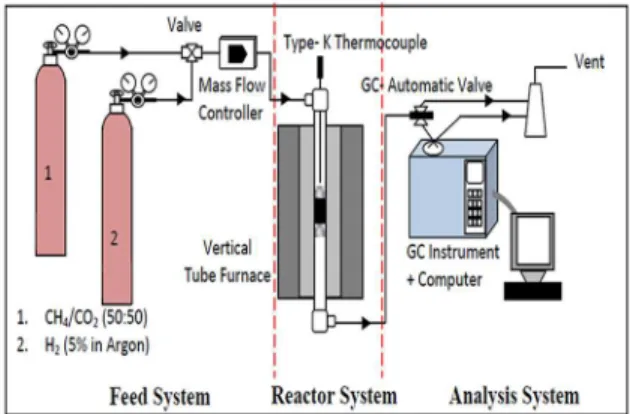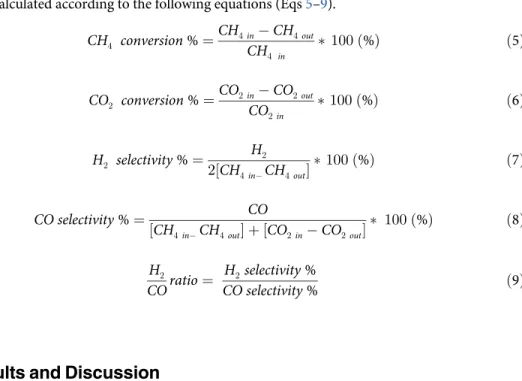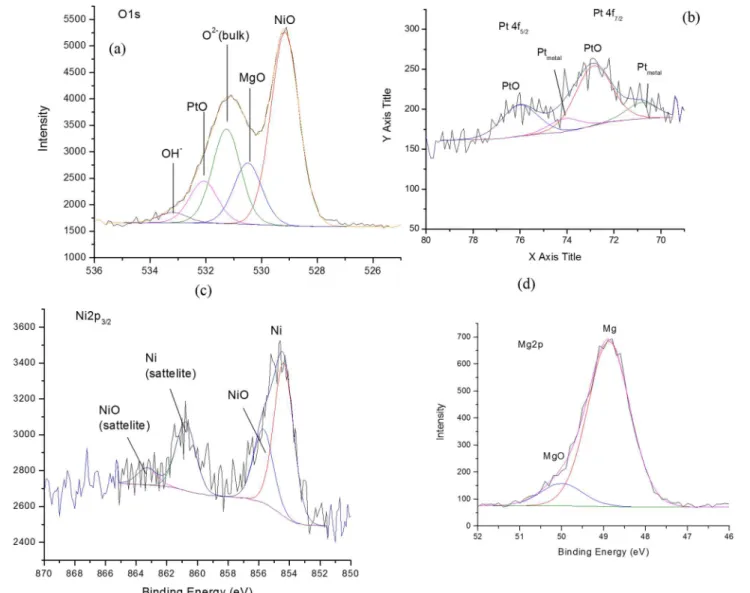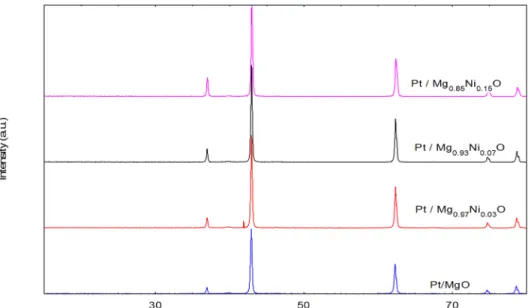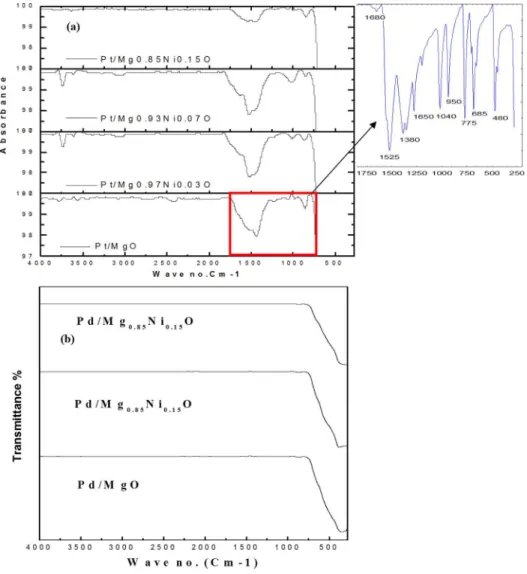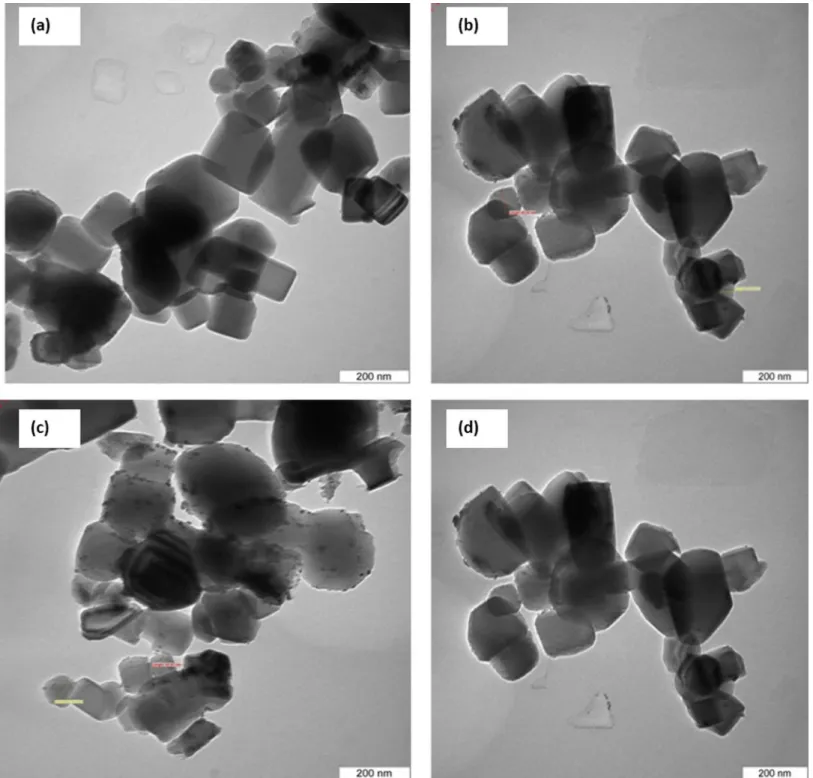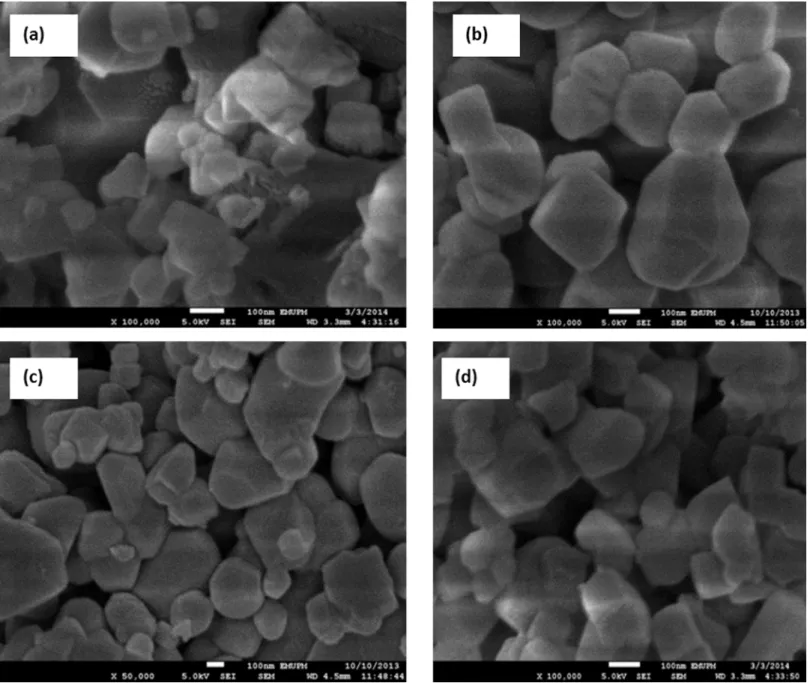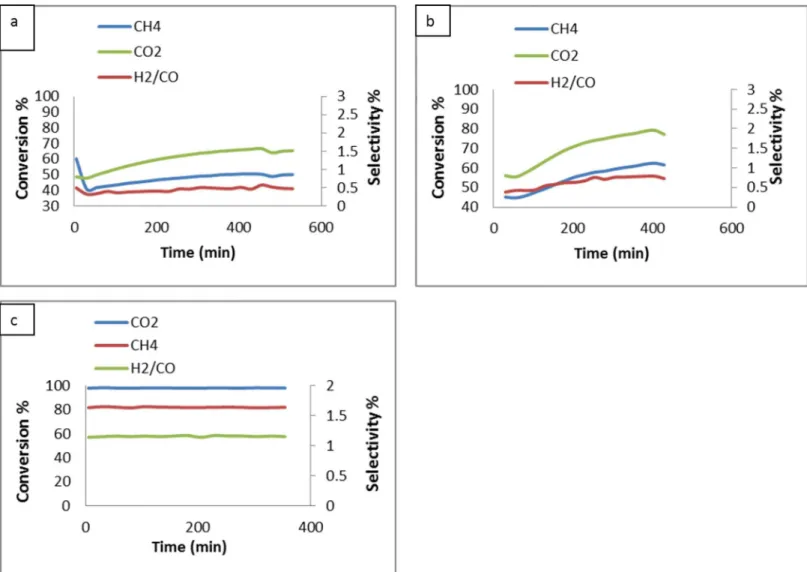High Coke-Resistance Pt/Mg
1-x
Ni
x
O Catalyst
for Dry Reforming of Methane
Faris A. J. Al-Doghachi1,2, Aminul Islam1,2, Zulkarnain Zainal1,2, Mohd Izham Saiman1,2, Zaidi Embong3, Yun Hin Taufiq-Yap1,2*
1Catalysis Science and Technology Research Centre, Faculty of Science, University Putra Malaysia, 43400, UPM, Serdang, Selangor, Malaysia,2Department of Chemistry, Faculty of Science, University Putra Malaysia, 43400, UPM, Serdang, Selangor, Malaysia,3Department of Science, Faculty of Science, Technology and Human Development, University TunHussienOnn Malaysia (UTHM), 86400, Parit Raja, Batu Pahat, Malaysia
*yap@science.upm.edu.my
Abstract
A highly active and stable nano structured Pt/Mg1-xNixO catalysts was developed by a
sim-ple co-precipitation method. The obtained Pt/Mg1-xNixO catalyst exhibited cubic structure
nanocatalyst with a size of 50–80 nm and realized CH4and CO2conversions as high as
98% at 900°C with excellent stability in the dry reforming of methane. The characterization of catalyst was performed using various kinds of analytical techniques including XRD, BET, XRF, TPR-H2, TGA, TEM, FESEM, FT-IR, and XPS analyses. Characterization of spent
catalyst further confirms that Pt/Mg1-xNixO catalyst has high coke-resistance for dry
reform-ing. Thus, the catalyst demonstrated in this study, offers a promising catalyst for resolving the dilemma between dispersion and reducibility of supported metal, as well as activity and stability during high temperature reactions.
Introduction
In recent decades, the demand for alternative energy resources has steadily increased owing to the ongoing depletion of fossil fuels. Therefore, the utilization of greenhouse gases such as methane and carbon dioxide has received much attention. The reservation of methane is larger than crude oil because methane can be produced from various sources, including shale gas, fer-mented wastes, methane hydrates and others [1]. The syngas, consisting of hydrogen and car-bon monoxide is an important feedstock for fuels and/or chemicals production in industry. The attractive feature of the dry reforming reaction is the utilization of CO2, which is a
green-house effect gas. In general, the dry reforming reaction (Eq 1) is typically accompanied by the simultaneous occurrence of the reverse water–gas shift reaction (RWGS) (Eq 2).
CH4 þ CO2 !2H2 DH¼247kJ=mol ð1Þ
CO2 þ H2 !CO þ 2H2O DH¼41:1kJ=mol ð2Þ
A variety of catalysts have been developed for this reaction. Among them, the catalysts based on noble metals are reported to be less sensitive to coking than the nickel-based catalysts. OPEN ACCESS
Citation:Al-Doghachi FAJ, Islam A, Zainal Z, Saiman MI, Embong Z, Taufiq-Yap YH (2016) High Coke-Resistance Pt/Mg1-xNixO Catalyst for Dry Reforming of Methane. PLoS ONE 11(1): e0145862. doi:10.1371/journal.pone.0145862
Editor:Gang Yang, Southwest University, CHINA
Received:June 25, 2015
Accepted:December 9, 2015
Published:January 8, 2016
Copyright:© 2016 Al-Doghachi et al. This is an open access article distributed under the terms of the Creative Commons Attribution License, which permits unrestricted use, distribution, and reproduction in any medium, provided the original author and source are credited.
Data Availability Statement:All relevant data are within the paper.
Funding:This work was supported by the University Putra Malaysia.
However, poor stability caused by carbon deposition (Eq 3andEq 4) and aggregation of active Ni metal limits the industrial application of Ni catalysts in DRM reactions [2–3].
CH4 !CðsÞ þ 2H2 DH¼ þ75kJ=mol ð3Þ
CO!CðsÞ þ CO2 DH¼ 171kJ=mol ð4Þ
It is well known that the performance of supported catalysts could be improved by selection of proper promoting materials. Supported transition metals, especially Ni, Ru, Rh, Pd, and Ir have considerable activity for reforming reactions. But supported nickel is preferred and more frequently used for industrial reforming processes because of its high availability and lower cost [4]. However, the Ni-based catalysts are readily deactivated by the deposition of carbon on the active centers.
Various promoters have been tested with metal-based catalysts in an attempt to decrease carbon deposition and prolong the life of the catalyst [5]. Maciel et al. [6] investigated the effect of metal-support interaction with the catalytic property of CuO/CeO2-TiO2catalyst towards
the conversion of hydrogen. However, the addition of ceria into the titania support hampers the transformation of anatase to rutile phase, facilitates the reduction of metal species and favors the metal-support interaction [7]. Choudhary et al. [8] reported CO2reforming with
simultaneous steam reforming or partial oxidation of methane to syngas over NdCoO3
perov-skite-type mixed metal oxide catalyst and found that the methane-to-syngas conversion pro-cess occurs in an energy highly efficient manner, requiring little or no external energy. Li et al. [9] investigated the partial oxidation and steaming reforming of methane to produce syngas or hydrogen using Al2O3-coated SiC foam monolith catalyst. The study of Li et al. [9] revealed
that the deposited carbon that originated from methane cracking in the upper part of the stain-less steel reactor. Alternatively, Kim et al. [10] studied the effect between the catalytic reaction and electric discharge on methanol–steam reforming on Cu/ZnO/Al2O3catalysts at various
temperatures and discharge voltages. On the other hand, rhodium based catalyst shows consid-erable activity in dry reforming of methane process [11]. Recently, Ferreira-Aparicio et al. [12] have noticed that the addition of low Rh contents on Ni/γ-Al2O3catalysts improves the activity
and stability of catalysts making them more convenient for their use at industrial scale. Recently, a similar conclusion has been reached by Ocsachoque et al. [13] who studied on Rh–
Ni/CeO2–Al2O3catalysts for methane dry reforming. Even though, the rhodium based catalyst
is a potential alternative with a small amount of carbon deposition and better catalytic perfor-mance, the dissociation of CO2occurred at Rh site and thus the metallic Rh was oxidized to
Rh+3[12]. A way to improve catalytic stability and anti-coking performance, the low Pt content modified Mg1-xNixO catalyst studied for dry reforming of methane in this study. The effect of
CH4and CO2concentration, catalyst concentration and temperature on conversion of syngas
were studied. The comparison between the catalytic activity and stability as well as coke forma-tion was also evaluated.
Sample Preparation and Characterization
Supports and Catalysts preparation
Mg1-xNixO (x= 0.00, 0.03, 0.07, 0.15) catalysts were prepared by the co-precipitation method as reported previously(Tomishige et al. 2004). Support MgO and promoter NiO was prepared using aqueous solution of Ni(NO3)2.6H2O (Merck;>99.0%) and Mg(NO3)2.6H2O (Merck;
>99.0%). Potassium carbonate (K2CO3) (Merck;>99.7%) was used as a precipitant. After
at 120°C for 12 hours and subsequently pre-calcined in air at 500°C for 5h. Subsequently, the sample was pressed into disks at 600 kg/m2, and then calcined at 1150°C for 20h.The
prepara-tion of catalyst was shown inTable 1. Finally, 1% Pt was impregnated using Pt(C5H7O2)2.H2O
(Acros Chemicals;>99%) dissolved with dichloromethane. The catalysts were dried at 120°C after impregnation in air for 12 h.
Catalyst characterization
The thermo gravimetricanalysis (TGA) was carried out on a Mettler Toledo TG-DTAAp-paratus (Pt crucibles, Pt / Pt−Rh thermocouple) with the purge gas (nitrogen) flow rate of 30 ml min−1and the heating rate of 10°C. min−1from 50 to 1000°C.
X-ray diffraction analysis was performed using aShimadzudiffractometer model XRD 6000. The diffractometer employed Cu-Kαradiation to generate diffraction patterns from powder
crystalline samples at ambient temperature. The Cu-Kαradiation was generated by Philips
glass diffraction X-ray tube broad focus 2.7 kW type. The crystallite size D of the samples was calculated using the Debye–Scherrer's relationship22, Where D is the crystalline size,λis the
incident X-ray wavelength,βis the full width at half-maximum (FWHM), andθis the
diffrac-tion angle.
The Fourier transform infrared (FT-IR) analysis was carried out with PerkinElmer spec-trometer model 100 series (sample preparation UATR).
The total surface area of the catalysts was obtained using Brunauer–Emmett–Teller (BET)
method with nitrogen adsorption at−196°C. Analysis was conducted using a Thermo Fisher Scientific S.P.A (model: Surfer Analyzer) nitrogen adsorption–desorption analyzer.
The Transmission Electron Microscopy (TEM, Model Hitachi H7100, Japan) was used to determine the crystal shape and Homogeneity of the Catalysts. Briefly, in deionized water, the powder was dispersed, dropped on to the Carbon-cover copper grids placed on a filter paper and at room temperature dried.
Field emission scanning electron microscopy (FE-SEM). The sample morphology was stud-ied with JEOL Field Emission Scanning Electron Microscope (FE-SEM) model JSM 7600F at very high magnification by using field emission current. The particles of the samples were glued up on aluminum stud by using a double–sided tape. Then, it was coated with gold to
make sure the better visibility of the surface and to prevent electrical charging of the sample during analysis.
The active site of the catalysts was evaluated by Temperature Programmed Reduction (TPR-H2) using hydrogen was conductedby Thermo Finnegan TPDRO 1100 apparatus
Equipped with a thermal conductivity detector. In the reactor, about 0.05 g of catalyst was placed and treated under 150°C for 40 min in N2(20 ml/min). The analysis of Hydrogen 5.51%
Table 1. Preparation of catalyst.
Catalyst Support (MgO)
Mg(NO3)2.6H2O(g)
Promoter (NiO) Ni(NO3)2.6H2O (g)
Total weight of MgO and NiO (g)
Impregnation of the main catalyst
(1% Pt) of Pt(acac)2.(g)
Pt/MgO 25.00 0.00 1 0.02
Pt/Mg0.97Ni0.03O 24.87 0.87 1 0.02
Pt/Mg0.93Ni0.07O 23.85 2.04 1 0.02
Pt/Mg0.85Ni0.15O 21.79 4.36 1 0.02
in Argon was carried out between 50°C and 950°C under argon flow (10°C min−1, 25 ml min−1)
and detected by a thermal conductivity detector.
XPS spectra were obtained using Kratos Axis Ultra DLD system, equipped with a mono-chromatic Al Kα(1486.6 eV), dual x-ray sources (Al & Mg), an argon etching system for sam-ple cleaning and depth profiling, parallel imaging XPS, AES, ISS and Vision software for controlling the system. The base pressure of the analyzer chamber was 1 × 10−10Torr. The
exci-tation sources, X-ray gun was operated at a combination of 20 mA of emissions current and 15 kV voltages. The hemispherical analyzer was operated in the fixed analyzer transmission (FAT) mode for both wide and narrow scanning. This value is set at 100 eV and 40 eV of pass energy respectively. The region of interest for the narrow scan is corresponding to Mg2p, Ni2p, Pt4f, and O1s photoelectron signal. The carbon charging correction refers to the binding energy of adventitious carbon at the binding energy of 285 eV. This highly sophisticated equip-ment is considered as a non-destructive analysis technique due to soft x-ray production to induce photoelectron emission from the sample surface. Therefore, the equipment would pro-vide information about surface layers or thin film structures (about the top 10–100 Å of the sample).
Catalyst evaluation
The catalytic evaluation for dry reforming of methane with CO2(DRM) towards syngas (H2/CO)
production was carried out using a fixed bed stainless steel micro-reactor (i.d. Ø = 6 mm,h= 34 cm) as shown inFig 1. The reactor was connected to a mass flow gas controller (SIERRA instrument) and an online gas chromatography (GC) (Agilent 6890N; G 1540N) equipped with varian capillary columns HP-PLOT/Q and HP-MOLSIV. Prior to reaction, approximately 0.02 g catalyst was reduced by flowing 5% H2/Ar (30 ml min-1) at 700°C and holding for 3h. The
reform-ing reaction was performed by flowreform-ing the feed, a gas mixture consistreform-ing of CH4/CO2in (2/1) and
(1/1) mol and CH4/CO2/O2(53.75/45/1.25), at a rate of 30 ml. min-1, the reforming has been
stud-ied from 700 to 900°C at 1 atm, then holding for 10h (1 atm, GHSV = 15000 ml h-1g-1cat).
The reduction step was aimed to reduce (Pt2+) phase to Pt metal (Pto) phase. The catalyst tested was placed in the middle of reactor vertically and held in place by plugs of quartz wool. In order to control and ensure the reaction temperature, a thermocouple was placed into the catalyst chamber. The selectivity of the CO was determined by ratio of moles of CO produced to sum of the moles of methane and CO2converted. The conversion of CH4, CO2, H2and CO
Fig 1. Experimental system for dry reforming of methane.
were calculated according to the following equations (Eqs5–9).
CH4 conversion%¼
CH4in CH4out
CH4 in
100ð%Þ ð5Þ
CO2 conversion%¼
CO2in CO2out CO2in
100ð%Þ ð6Þ
H2 selectivity%¼
H2
2½CH
4in CH4out
100ð%Þ ð7Þ
CO selectivity%¼ CO
½CH4in CH4out þ ½CO2in CO2out
100ð%Þ ð8Þ
H2
COratio¼
H2selectivity%
CO selectivity% ð9Þ
Results and Discussion
Characterization of catalysts
The TGA analysis of the prepared catalysts was illustrated inFig 2. The weight loss of 4% observed at temperatures 41°C and 266°C could be attributed to the removal of moisture from the catalyst, as shown inFig 2A. The compound was found to be thermally stable at 500°C which could be associated with the high melting point of MgO (2852°C) and NiO (1955°C). The similar natures of thermal decomposition of other catalysts were observed inFig 2B–2D. This observation is in agreement with the results reported in the literatures [14–15].
Information on the surface composition of the catalyst was obtained by XPS analysis. Sur-face study of the catalyst at a few nanometer layer 3–12 nm of its uppermost using XPS indicate
Fig 2. TG of the catalysts (a) Pt/MgO (b) Pt/Mg0.85Ni0.15O(c) Pt/Mg0.97Ni0.03O (d) Pt/Mg0.93Ni0.07O.
that there is a photoelectron signal from O1s, Mg2p, Ni2p and Pt4f, as illustrated inFig 3. A deconvolution of a O1s photoelectron signal shows that it is contributed by five types of oxygen species which is contributed by O2-(from the bulk), Mg-O, Ni-O, Pt-O and hydroxyl (OH-)
component. This is also a significant splitting of this O1s spectrum, whereby Ni-O exhibit as the highest intensity of photoelectron signal in the lower binding energy region compared to the others. However, the O2-, Ni-O, Pt-O and OH-were detected under a similar photoelectron envelope. The contribution of the OH-component is considered very low at the binding energy
of 533.0 eV. On the other hand, the narrow scan of Mg2p, Ni2p and Pt4f revealed that the oxide species of these metals are a mixture of Mg-O and Mg(OH)2, Ni and Ni-O, and Pt-O and
Pt respectively. The existence of two components of hydroxyl species by Ni and Mg indicated that these metals are easy to react with water vapor compound (H2O) [16–17].
X-Ray Diffraction (XRD) patterns of the catalysts are shown inFig 4. The diffraction peaks at 2θ= 39.7, 42.9, 62.5, 75.0 and 79.0° were associated with the cubic form of magnesia (JCPDS
file no.: 00-024-0712). The value of 2θat 37.3, 43.3, 62.7, 75.1, and 79.8 were corresponds to
Fig 3. XPS narrow scan of the reduced catalyst.(a) O1s (b) Pt4f (c) Ni2p (d) Mg2p.
the cubic form of NiO (JCPDS file no.: 00-001-0800). No diffraction peak of Pt in the patterns was observed as it exists in very low concentration. This observation agrees well with the results reported by Grange [18]. The average crystalline size was determined by the diffraction peak of the Mg plane in XRD patterns using the Debye-Scherrer equation (Table 2). The size of the crystals were 44.7, 42.4, 40.4 and 38.7 nm for Pt / Mg0.97Ni0.03O, Pt/ Mg0.93Ni0.07O, Pt /
Mg0.85Ni0.15O and Pt/MgO, respectively. The results revealed that the crystal size was
decreased with increasing Ni concentration. This could be due the effect of platinum that remain bounded on the surface of the samples and inhibit the growth of magnesia crystallites [19]. Further, it was reported by Jogalekar et al. [20] that the addition of nickel oxide coluld prevent agglomeration of the magnesia particles and thus, decrease in particle size.
The crystal system for all the samples was cubic, as confirmed by TEM and FESEM analyses.
The H2-TPR has been extensively used to characterize the Ni reducibility of the reforming
Ni catalysts. The TPR-H2profiles for the Pt/Mg1-xNixO catalysts are presented inFig 5. For
comparison the reducibility and different Ni concentration in the MgO support platinum cata-lysts were investigated.Fig 5shows all of the catalysts had a broad and overlapping H2
con-sumption peak at 50 to 950°C, indicating the different interactions of Pt with the support [21].
Fig 4. XRD results of catalysts (a) Pt/MgO(b) Pt/Mg0.97Ni0.0(c) Pt/Mg0.93Ni0.07O (d) Pt/Mg0.85Ni0.15O.
doi:10.1371/journal.pone.0145862.g004
Table 2. The main textural properties of fresh catalysts.
Sample name SpecificaSurface Area m2/g
Pore
Volume Cm3/g
Pore volume to SBETratio 10-9m
Pore radius °A PtbLoading Wt % AveragecCrystal size nm
Pt / Mg0.97Ni0.03O 11.64 0.17 17.6 18.25 0.98 44.7
Pt / Mg0.93Ni0.07O 6.72 0.06 15.7 18.26 0.94 42.4
Pt / Mg0.85Ni0.15O 5.44 0.04 10.6 18.24 0.93 40.4
Pt / MgO 10.46 0.41 48.4 18.26 0.95 38.7
a. Specific surface area calculated by BET method. b. Determined by the XRF method.
c. Determined by the Debye-Scherrer equation of the Mg (200) plane of XRD.
The peaks shown in TPR profile (Fig 5) at 215, 220 and 219°C could be attributed to the reduc-tion of Pt-O to Pt. The other broad peaks at 465, 470 and 485°Cfor Pt/Mg0.97Ni0.03O, Pt/
Mg0.93Ni0.07O, and Pt/Mg0.85Ni0.15O catalyst were associated with the reduction of Ni-O to
Ni0. The reduction peak of NiO is shifted to a lower temperature when it is deposited on the MgO support [22]. It is likely that the better-dispersed Ni and an appropriate interaction between metal and support increase the Ni reducibility. The TPR-H2profiles confirmed that
700°C was the appropriate re-reduction temperature for the complete reduction of catalysts. These peaks might relate to the reduction of nickel oxide particles supported on the outside surface and inside the porous structure of the catalysts, which can be clearly distinguished by TEM results.
Fig 5. H2-TPR profiles o catalysts (reduced in a 5% H2/Ar stream at a temperature ramp of 10°C/min).(a) Pt/Mg0.97Ni0.03O (b) Pt/Mg0.93Ni0.07O (c) Pt/ Mg0.85Ni0.15O (d) Pt/MgO.
FTIR spectra for un-reduced and reduced catalysts depicted inFig 6. As shown inFig 6A, the sharp peaks around 1525 Cm-1which represents the C = C stretch for each catalyst. Broad
peaks at 3050 Cm-1represented the C-H bond. Moreover, the band at 1680 Cm-1can be
assigned to the vibration of carbonyl (C = O) group in the acetylactonate on the catalyst. The band at 1380 cm-1and 1040 cm-1can be assigned to the existence of C-H bending C-O stretch,
respectively. The band in the region 680 to 700 Cm-1was attributed to the NiO stretching,
vibration mode, whereas, the vibration bonds for Pt-O and MgO exists in the far IR region [23, 15]. However, all the acetylactonate peaks was disappearing after reduction at 700 °C, as shown inFig 6B.
The BET specific surface area (SBET) value and pore properties of catalyst supports are shown inTable 2. After impregnation, the SBETvalue and pore volume decreased in all three of the cata-lysts. This phenomenon might be caused by pore blocking during the impregnation process. Consistent with earlier reports [24], the platinum doped Mg0.97Ni0.03O sample showed a higher
surface area as compared to the magnesium oxide sample. The dispersed platinum particles along with the support prevent the agglomeration of catalyst particles leading to an enhanced surface area. Furthermore, the pore volume of the samples was decreased trend with increasing
Fig 6. FT-IR of (a) unreduced and (b) reduced catalysts.
nickel oxide in the magnesium oxide. It can be assumed that the incorporation of NiO prevents surface area loss during high temperature calcinations resulting in increase the surface area of the samples. There was no obvious connection between the SBETvalue and pore volume of catalysts, but the pore volume/SBETratio decreased in the order Pt / MgO>Pt / Mg0.97Ni0.03O>Pt /
Mg0.93Ni0.07O>Pt / Mg0.85Ni0.15O, which was in accordance with the NiO dispersion order.
This result is consistent with the result reported by Saha et al. [24] that the high pore volume/S BE-Tratio contributes to high catalytic performance. The XRF results inTable 2show that the Pt-loading was slightly lower than the set value of 10%. This might be caused by weight loss during the pre-calcinations of the supports, resulting in a higher Ni content in the catalysts [25].
To estimate the morphology of the catalyst, TEM images of one samples were acquired.Fig 7illustrates the morphology and size distribution of the synthesized catalysts. The smallest crystals were characterized by TEM, which reveals crystals with a size of about 50–80 nm, and even resolves the cubic structure. The average size of the Pt nanoparticle with various sizes from 4–7 nm. The morphology of the catalyst could be supported by FESEM analysis (Fig 8). The supports particles are regular inshape Pt particles were uniformly distributed on supports. A two-dimensional cubic texture is assigned to the catalyst and uniform pore size of ~5 nm was observed (Table 2). This is consistent with the results reported by other researchers [26]. The particle size of supported Pt increased in the order of Pt/Mg0.85Ni0.15O<Pt/Mg0.93Ni0.07O<
Pt/Mg0.97Ni0.03O, which was in agreement with the Scherrer’s equation results.
Catalytic performance
Effect of reactant concentration on conversion. Effect of catalyst type on CH4, CO2and
H2/CO conversion with the CO2/CH4ratio of 1:2 at 900°C was shown inFig 9. The conversion
of CH4and CO2to syngas was expressed by the H2/CO ratio. The detection of H2and CO after
the blank tests (reaction without catalyst) performed at 900°C was indicated the decomposition of methane reaction according to the reaction (Eq 1). When MgO was used alone as a support without NiO, the conversion of CH4and CO2was low, as shown inFig 9A. These results
indi-cated that the conversion of syngas using MgO is very low. When support with promoter (Mg0.85Ni0.15O) was used, the conversion of syngas was increased (Fig 9B). The enhancement
was due to the presence of promoter NiO. On the other hand, the conversion and the H2/CO
ratio increased sharply for the case of Pt/Mg0.85Ni0.15O catalyst (Fig 9C). The result revealed
that the main catalyst (Pt metal) doped on the support plays the main role in the catalyst. By using the Pt/Mg0.85Ni0.15O catalyst, the average conversion of CH4and CO2gases at the ratio
(2:1) was 81 and 97%, respectively, whereas the conversion of the gases at the ratio (1:1) was 76 and 95% respectively (Fig 10). This could be due the best resistance to the deactivation of the catalyst and thus, the high selectivity towards the conversion of H2and CO was observed.
Effect of catalyst concentration on conversion. The effect of catalyst concentration on conversion was shown inFig 11. The increasing order of conversion of CH4, CO2and the H2/
CO ratio was Pt/MgO<Pt/Mg0.97Ni0.03O<Pt/Mg0.93Ni0.07O<Pt/Mg0.85Ni0.15O. No change
in conversion, selectivity of CH4and CO2with increasing the Ni concentration in the support,
was observed. This could be attributed to the formation of strong Lewis basicity with a metal oxide support. The increase of the Lewis basicity of the support could be enhanced the ability of the catalyst to chemisorbs CO2in the CO2reforming of methane.The adsorbed CO2can
reacts with C to form CO, resulting the reduction of coke formation according to the equation (Eq 10).
CO2 þ C !2CO DH¼171kJ=mol ð10Þ
carbon deposition. The support MgO is strong Lewis bases, which has a strong adsorption of CO2to reduce or inhibit carbon deposition. Furthermore, XPS results revealed that the
reduc-tion of NiO in NiO–MgO solid solution was much more difficult than that of pure NiO, leading to small nickel metal particles formed on the surface [27–28].
Fig 7. TEM image of catalysts(a) Pt/MgO(b) Pt/Mg0.97Ni0.03O(c) Pt/Mg0.93Ni0.07O (d) Pt/Mg0.85Ni0.15O.
Effect of temperature on conversion. Fig 12shows the activity and selectivity results of the Pt/Mg0.85Ni0.15O catalyst. The conversion of both CH4:CO2(2:1) increased as the
tempera-ture was increased from 700 to 900°C. The dry-reforming of methane reaction is a strong endo-thermic reaction (Eq 1) and resulting the high temperature can be increased the conversion rate, as observed in earlier studies [29]. The CH4conversion on Pt / Mg0.85Ni0.15O increased
from 34% to 82% and the CO2conversion increased from 38% to 98% when the temperature
increased from 700 to 900°C. At temperatures above 900°C, no increase in CH4and CO2
con-version was evident. The H2/CO ratio of the catalyst at various temperatures is shown inFig
12A–12C. The H2/CO ratio of the samples was less than 1 at the temperature above 900°C. The
reverse water-gas-shift reaction (Eq 11) can consume the additional H2and produces CO,
Fig 8. FESEM image of catalysts (a) Pt/MgO(b) Pt/Mg0.97Ni0.03O, (c) Pt/Mg0.93Ni0.07O (d) Pt/Mg0.85Ni0.15O.
which lowers the H2/CO ratio [29].
CO2 þ H2!CO þ H2O DH¼ þ41:2kJ=mol ð11Þ
Stability tests
Temperature tests, as shown inFig 13, was indicated the higher conversion of CH4and CO2
conversion at 900°C. The detection of H2and CO after the blank test at 900°C indicates the
decomposition methane (Eq 4). Therefore, 900°C was chosen as the appropriate temperature to conduct stability tests.Fig 13Ashows the 200 h on-stream catalyst test results for the catalyst sample at 900°C. The sample showed good stability during the 200 h on-stream, and no decay of activity was found in the sample. The conversion of CH4was lower than the conversion of
CO2. The average conversion of CH4and CO2, were 82 and 98% respectively which was
reduced to. after 46 h of reaction time. Following that the conversion remained stable till it reached to 200 h. The higher the degree of the reverse water gas shift reaction process, the larger difference between CH4and CO2conversion, and the lower the H2/CO ratio. These
Fig 9. Effect of catalyst type on CH4, CO2and H2/CO conversion with CO2/CH4= 1:2 at 900°C; (a) Support(MgO); b) Support with promoter (Mg0.85Ni0.15O) and c) Catalyst (Pt/Mg0.85Ni0.15O)
theoretical considerations are confirmed by the actual test results shown inFig 13A. Further the catalyst was reused in successive cycle for 200 h and the results was shown inFig 13B. No significant reduction of CH4, CO2conversion was observed.
TPO-MS post-reaction test was used to evaluate coke formation on the Mg0.85Ni0.15O and
Pt/Mg0.85Ni0.15O catalysts (Fig 14). The TPO profiles inFig 14Ashows the desorption at 600°C
indicating the coke deposition on Mg0.85Ni0.15O catalyst surface. However, No coke deposition
was observed on the Pt/Mg0.85Ni0.15O catalyst as evident fromFig 14B. TEM analysis for the
spent Pt/Mg0.85Ni0.15O and Mg0.85Ni0.15O was supported the above finding represented inFig
15. The results of TPO and TEM indicated the role of platinum metal (main catalyst) on the surface of the catalyst. However, aggregation of the Pt particle after reaction at 900°C as shown inFig 15A and 15B, can be described by a simple Oswald ripening approach. A size-dependent morphology of the supported Pt nanoparticles may influence the ripening process in several ways. The observed growth of the projected nanoparticle areas in the TEM images depends on the nanoparticle volume, which is described in terms of the height-to-diameter ratio [30]. The nanoparticle perimeter at the Pt-oxide interface can emit or absorb diffusing species resulting in agglomeration of particle. According to Maillard et al. [30] high concentration of metal load-ing may results, in increase of the average diameter of isolated Pt nanoparticles
Temperature tests, as shown inFig 12indicated that both CH4and CO2conversion was
increased at 900°C. However, the carbon can be deposited on the Pt metal surface, according to the following mechanism (Eqs12–16), as proposed by Topalidis et al. [31].
CH4þ2PtðasÞ ! CH3PtðasÞ þHPtðasÞ ð12Þ
CH3PtðasÞþPtðasÞ ! CH2PtðasÞ þHPtðasÞ ð13Þ
CH2PtðasÞ þPtðasÞ ! CHPtðasÞ þHPtðasÞ ð14Þ
CHPtðasÞ þPtðasÞ ! CPtðasÞ þHPtðasÞ ð15Þ
2HPt
ðasÞ ! H2ðgÞ þ2PtðasÞ ð16Þ
Fig 10. Effect of CH4/CO2ratio on the on CH4, CO2and H2/CO conversion at 900°C; (a) 2:1; b) 1:1.
The effect of NiO promoter in the catalyst on dry reforming of methane has been proposed by Nakamura et al. [32]. According to the mechanism (Eqs17–21), CO2is activated on the
support in proximity to the metal particle to form a carbonate species. Following that, the car-bonate is reduced by CHxspecies to form carbon monoxide (CO).
CO2ðgÞ ! CO2ðsupportÞ ð17Þ
CO2ðsupportÞ þ O
2
ðsupportÞ ! CO3 2
ðsupportÞ ð18Þ
CO2ðgÞ ! CO2ðsupportÞ ð19Þ
CO3 2
ðsupportÞ þ 2HðsupportÞ ! HCO3 2
ðsupportÞ þOH ðsupportÞ ð20Þ
COðsupportÞ! COðgÞ ð21Þ Fig 11. Effect of catalyst concentration on H4, CO2and H2/CO conversion with CO2/CH4= 1:2, at 900°C; (a) Pt/MgO b) Pt/Mg0.97Ni0.03O c) Pt/ Mg0.93Ni0.07O d) Pt/Mg0.85Ni0.15
Carbon formation on the main catalyst (Pt metal) of the dry reforming of methane reaction was eliminated by the role of Ni metal as shown inS1 FigThe CO2adsorption was enhanced
by the presence of NiO as it increases the basicity of the catalyst. Following the adsorption, for-mation of carbonate species, mostly occurred on the NiO, which later dissociated to CO2into
CO and O. The oxygen atom then took by Ni metal on the surface reacted with the carbon deposited on the metal and produced CO [33]. When the lower concentrations of NiO, the CO2conversion was increased by forming strongly ionic oxides NiCO3, which resulted in the
attraction of CO2to the catalyst surface and, therefore, increased CH4conversion. When NiO
was present in higher concentrations, the conversion of both CH4and CO2decreased. This
probably happened as a result of increase in Pt electron density [34]. The NiCO3species
partic-ipated directly in DRM by decomposing to produce CO and providing oxygen species to react with the carbon deposited at the interface of Pt-NiCO3. Likewise, NiO supported catalysts can
facilitate the dissociation of adsorbed CO2.
Dry reforming of biogas reaction can be enhanced by carried out with the presence of low concentrations of oxygen flow (1.25%).Fig 16shows the increament of CH4conversion from
82 to 95% due to adding supply of oxygen to the DRM reactant mixture [35]. However, the CO2conversion and the H2/CO ratio were not affected might be due to the reaction of oxygen
with CH4to produce CO and H2O (Eq 22), and finally the steam reacts with the deposited
Fig 12. Effect of temperature on H4, CO2and H2/CO conversion for Pt/Mg0.85Ni0.15O catalyst with CO2/CH4= 1:2; (a) 700°C (b)800°C (c) 900°C
carbon to give syngas according to theEq 23. Furthermore, O2can be reduced coke deposition
on the catalyst (Eq 24). Dry reforming of methane has been investigated with noble (Rh, Ru, Pd and Pt) and non-noble metal (Ni, Co and Fe) based catalysts [36]. A conclusion has been by the researchers [36–38] that their superior coking resistance, higher stability and activity are especially for higher temperature applications (>750°C). Hou et al. [37] incorporated different active metals (Rh, Ru, Pt, Pd, Ir, Ni and Co) over alumina and the influence of noble metals (Rh, Ru, Pt, Pd, Ir) on the coking resistance ability of the catalyst has been examined. The cata-lytic activity and stability trend of the catalysts reported by Hou et al. [37] was Rh/α
-Al2O3>Ru/α-Al2O3>Ir/α-Al2O3>Pd/α-Al2O3>Pt/α-Al2O3. Similarly, the catalytic activity
Fig 13. Stability tests of Pt / Mg0.85Ni0.15O fresh catalysts (a) and recycled catalysts at 900°C for 200 h (GHSV = 15000 ml cat-1h-1, atmospheric pressure).
and stability for Pd, Pt and Au catalysts as investigated by Tsyganok et al. [39] were Pd/MgA-lOx>Pt/MgAlOx>Au/MgAlOx. It was reported that high dispersion of Pt or Au and and smaller particle size assisted in the reduction of carbon deposits, agglomeration and sintering [39]. A comparison of noble (Rh, Ru, Pd, Ir and Pt) and non-noble (Ni and Co) metal catalysts was made by Tsyganok et al. [39] and reported that the Ni and Co catalysts showed higher cat-alytic activities compared to the noble metal supported catalysts. However, the higher coke deposition for Ni (24.0) and Co catalysts indicate their poor coke resistance ability compared
Fig 14. TPO curves of a) Mg0.85Ni0.15O b) Pt/Mg0.85Ni0.15O catalysts after 200h reaction with CO2/CH4= 1:2 at 900°C.
to noble metal catalysts. Thus, the deactivation arising from the coke deposition is the major obstacle in the application of Ni-based catalyst. Other workers [40] have discussed a similar phenomenon and reported that bimetallic catalyst (0.4Pt−Ni/γ-Al2O3) showed lower carbon
deposition (6 wt%) compared to the monometallic (Ni/γ-Al2O3) catalyst (45 wt%). This
indi-cates that addition of noble metals to Ni catalyst leads to the reduction of carbon deposition and produced smaller particle size compared to monometallic Ni catalysts. As a result of this process the carbon deposition is reduced and consequently the lifetime of the catalyst could be
Fig 15. TEM analysis of (a) Pt/Mg0.85Ni0.15O catalyst; (b) Mg0.85Ni0.15O and respective Pt size distribution after reaction with CO2/CH4= 1:2 at 900°C.
improved using Pt/Mg1-xNixO catalyst.
CH4 þ 1:5O2 !CO þ2H2OðvÞ ð22Þ
CðsÞ þ H2O !CO þH2 ð23Þ
CðsÞ þ O2 !CO2 ð24Þ
Conclusion
The results presented in this paper demonstrate that the addition of nickel to the support has several promotional effects. The promoters can increase the thermal stability of the Pt/ Mg1-xNixO catalyst by stabilizing the cubic phase of magnesia.The narrow scan of Mg2p, Ni2p
and Pt4f revealed that the oxide species of these metals are a mixture of MgO and Mg(OH)2,
NiO and Ni(OH)2and PtO respectively. This stabilization results in an increase in the surface
area and thus, increases in the density of CO2adsorption sites near the metal particle. Hence,
the ability of the support to enhance the dissociation of CO2near the Pt particle and the
trans-fer of oxygen to the coked metal greatly accelerates the cleaning mechanism.These facts emphasize that the incorporation of Pt and Ni species in the catalyst prevent coke formation onto the catalyst and increase the syngas production from greenhouse gasses over Pt/ Mg1-xNixO catalysts.
Fig 16. DRM reaction of the Pt/Mg0.85Ni0.15O catalyst under 900°C with 1.25% O2.
Supporting Information
S1 Fig. Effect of promoter to remove carbon from Pt. (TIF)
Author Contributions
Conceived and designed the experiments: FAJA AI. Performed the experiments: AI FAJA. Analyzed the data: AI FAJA ZZ YHTY. Contributed reagents/materials/analysis tools: AI FAJA ZZ YHTY. Wrote the paper: MIS ZE AI FAJA YHTY.
References
1. Sutthiumporn K., Maneerung T., Kathiraser Y., Kawi S., 2012. CO2dry-reforming of methane over La0.8Sr0.2Ni0.8M0.2O3perovskite (M = Bi, Co, Cr, Cu, Fe) roles of lattice oxygen on C-H activation and carbon suppression. Int. J. Hydrog. Energy 37, 11195–11207.
2. Chen P., Zhang H. B., Lin G. D., Tsai K. R., 1998. Development of coking-resistant Ni-based catalyst for partial oxidation and CO2reforming of methane to syngas. Appl. Catal. 166, 343–50.
3. Hu Y. H., Ruckenstein E., 1997. CH4TPR-MS of NiO/MgO solid solution catalysts. Langmuir, 13(7), 2055–2058.
4. Choudhary V. R.,Mamman A. S., 2000. Energy efficient conversion of methane to syngas over NiO– MgO solid solution. Appl. Energy, 66(2), 161–175.
5. Xu X., Li P., Shen Y., 2013.Small-scale reforming of diesel and jet fuels to make hydrogen and syngas for fuel cells: A review. Appl. Energy 108, 202–217.
6. Maciel C. G., de Freitas Silva T., Assaf E. M., Assaf J. M., 2013. Hydrogen production and purification from the water–gas shift reaction on CuO/CeO2–TiO2catalysts. Appl. Energy 112, 52–59.
7. Khobragade M., Majhi S., Pant K. K, 2012. Effect of K and CeO2promoters on the activity of Co/SiO2 catalyst for liquid fuel production from syngas. Appl. Energy 94, 385–394.
8. Choudhary V. R., Mondal K. C., 2006. CO2reforming of methane combined with steam reforming or partial oxidation of methane to syngas over NdCoO3perovskite-type mixed metal-oxide catalyst. Appl. Energy 83(9), 1024–1032.
9. Li C., Xu H., Hou S., Sun J., Meng F., Ma J. et al. 2013. SiC foam monolith catalyst for pressurized adia-batic methane reforming. Appl. Energy, 107, 297–303.
10. Kim T., Jo S., Song Y. H.,Lee D. H., 2014. Synergetic mechanism of methanol–steam reforming reac-tion in a catalytic reactor with electric discharges. Appl. Energy 113, 1692–1699.
11. Wei-Hsin C., Shih-Cheng L., 2015. Characterization of catalytic partial oxidation of methane with car-bon dioxide utilization and excess enthalpy recovery, Appl Energy, Available online 7 February. 12. Ferreira-Aparicio P., Fernandez-Garcia M., Guerrero-Ruiz A., Rodrı&´guez-Ramos I., 2000. Evaluation
of the Role of the Metal–Support Interfacial Centers in the Dry Reforming of Methane on Alumina-Sup-ported Rhodium Catalysts. J. Catal. 190(2), 296–308.
13. Ocsachoque M., Pompeo F., & Gonzalez G., 2011. Rh–Ni/CeO 2–Al 2 O 3 catalysts for methane dry reforming. Catal. Today, 172(1), 226–231
14. Aldbea F. W., Ibrahim N. B., Mustaffa H. A., Ramadan E. S., 2012. Structural and Magnetic Properties of TbxY3-xFe5O12(0 ea, F. W., Ibrahim, N. B., Mustaffa, H. A., RamaJ. Sol-Gel Sci. Technol. 62 (3),483–89.
15. MojovićZ., Mentus S., TešićŽ., 2004. Introduction of Pt and Pd nanoclusters in zeolite cavities by
ther-mal degradation of acetylacetonates. In Mate. Sci. Forum 453, 257–262.
16. Mei Z., Li Y., Fan M., Zhao L., Zhao J., 2015. Effect of the interactions between Pt species and ceria on Pt/ceria catalysts for water gas shift: The XPS studies. Chem. Eng. J. 259, 293–302.
17. Hidalgo-Carrillo Jesús et al., 2012. XPS Evidence for Structure-Performance Relationship in Selective Hydrogenation of Crotonaldehyde to Crotyl Alcohol on Platinum Systems Supported on Natural Phos-phates.J. Colloid Interface Sci. 382(1), 67–73. doi:10.1016/j.jcis.2012.05.050PMID:22762986 18. Grange P.,1980. Catalytic Hydrodesulfurization. Catal. Rev. Sci. Eng. 21(1), 135–181.
19. Wang X., et al., 2012. Efficient Conversion of Microcrystalline Cellulose to 1,2-Alkanediols over Sup-ported Ni CatalystsGreen Chem. 14(3), 758.
21. Abatzoglou N., Fauteux‐Lefebvre C., 2015.Review of catalytic syngas production through steam or dry reforming and partial oxidation of study liquid compounds. Wiley Interdisciplinary Reviews: Energy and Environment.
22. Wu G., Zhang C., Li S., Han Z., Wang T., Ma X., Gong J., 2013. Hydrogen production via glycerol steam reforming over Ni/Al2O3: influence of nickel precursors. ACS Sust. Chem. Eng. 1 (8), 1052– 1062.
23. Qiao H., Wei Z., Hua Y., Lin Z., Xiaoyan Y. X., 2009.Preparation and Characterization of NiO Nanoparti-cles by Anodic Arc Plasma Method. J. Nanomater. 239, 238–243.
24. Saha B., Khan A., Ibrahim H., Idem R., 2014. Evaluating the performance of non-precious metal based catalysts for sulfur-tolerance during the dry reforming of biogas. Fuel 120, 202–217.
25. Chen X., Yik E., Butler J., Schwank J. W., 2014. Gasification characteristics of carbon species derived from model reforming compound over Ni/Ce–Zr–O catalysts. Catal. Today 233, 14–20.
26. Qian X., et al., 2014. A Novel Low Temperature Vapor Phase Hydrolysis Method for the Production of Nano-Structured Silica Materials Using Silicon Tetrachloride,RSC Adv. 4(17), 8703.
27. Hu Y. H., 2009.Solid-Solution Catalysts for CO2Reforming of Methane. Catal. Today 148(3–4), 206– 11.
28. Tomishige K., Himen Y., Matsuo Y., Yoshinaga Y., Fujimoto K., 2000. Catalytic performance and car-bon deposition behavior of a NiO-MgO solid solution in methane reforming with carcar-bon dioxide under pressurized conditions. Ind. Eng. Chem. Res. 39(6), 1891–1897.
29. Appari S., Janardhanan V. M., Bauri R., Jayanti S., Deutschmann O., 2014. A Detailed Kinetic Model for Biogas Steam Reforming on Ni and Catalyst Deactivation due to Sulfur Poisoning. Appl. Catal. A-Gen. 471, 118–25.
30. Maillard F., Schreier S., Hanzlik M., Savinova E. R., Weinkauf S., Stimming U., 2005. Influence of parti-cle agglomeration on the catalytic activity of carbon-supported Pt nanopartiparti-cles in CO monolayer oxida-tion.Physical Chemistry Chemical Physics, 7(2), 385–393.
31. Topalidis A., Petrakis D. E., Ladavos A., Loukatzikou L., Pomonis P. J., 2007. A kinetic study of meth-ane and carbon dioxide interconversion over 0.5% Pt/SrTiO3catalysts. Catal. Today 127(1), 238–245. 32. Nakamura J., Aikawa K., Sato K., Uchijima T., 1994.Role of support in reforming of CH4with CO2over
Rh catalysts, Catal. Lett. 25, 265–270.
33. Osaki T., Mori T., 2001. Design and Preparation of Ni-Co Bimetallic Nanocatalyst for Carbon Dioxide Reforming of Methan, J. Catal. 204, 89–97.
34. Dias J. C., Assaf J. M., 2003. Influence of cadmium content in NiO/CaO/Al2O3Catalysis for CO2-reforming of methane. Catal. Today 85, 59–68.
35. Tomishige K., 2004. Syngas Production from Methane Reforming with CO2/H2O and O2over NiO-MgO Solid Solution Catalyst in Fluidized Bed Reactors. Catal. Today 89(4), 405–18.
36. Liu D., Quek X. Y., Cheo W. N. E., Lau R., Borgna A., Yang Y., 2009. MCM-41 supported nickel-based bimetallic catalysts with superior stability during carbon dioxide reforming of methane: Effect of strong metal–support interaction. J. Catal. 266(2), 380–390.
37. Hou Z., Chen P., Fang H., Zheng X., & Yashima T., 2006. Production of synthesis gas via methane reforming with CO2 on noble metals and small amount of noble-(Rh-) promoted Ni catalysts. Int. J. Hydrogen Energy 31(5), 555–561.
38. DjinovićP.,Črnivec I. G. O., Batista J., Levec J., Pintar A., 2011. Catalytic syngas production from greenhouse gasses: Performance comparison of Ru-Al 2 O 3 and Rh-CeO 2 catalysts. Chem. Eng. Process. 50(10), 1054–1062.
39. Tsyganok A. I., Inaba M., Tsunoda T., Hamakawa S., Suzuki K., Hayakawa T., 2003. Dry reforming of methane over supported noble metals: a novel approach to preparing catalysts. Catal. Commun. 4(9), 493–498.

